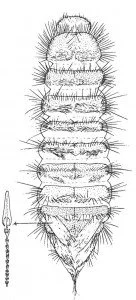
Many of the beetle larvae that are common in Denmark, especially the larder beetle larvae (Dermestidae), have very crafty hair. Some larder beetle larvae have spines on their tale end. The spines end in something that resembles a harpoon with 4-6 long barbs and along the shaft are 30-40 shell crests of barbs facing upwards. If larder beetle larvae feel threatened by other bugs, they turn the tail against the attacker and put up the spines. This usually results in some of them being ripped off. This troubles the attacker and can even lock the attacking animal’s limbs together so that it succumbs.
Hair from larder beetle larva can also penetrate human skin. This might happen when you’re lying on a mattress, which has been visited by carpet beetles (Anthrenus spp.) or if other larder beetles from bird nests or food will find their way to clothing or furniture with which humans have contact. On the skin, a dark spot appears.
It is the larder beetle larvae hair or a part of it. First, a red, irritated area will appear around the hair. Next, is a small, clear blister will appear. The blister may turn yellow after a few days (inflammation). Inflammation can sometimes be avoided, if the hair is pulled out using a needle and tweezers, however, it is not always possible.
Eradication. First, try to find out where the larder beetle larvae are coming from and either fight with poison or keep them out. Then, attempt to remove the larder beetle larva, their empty skins and loose hairs. Repeated vacuuming can do the job.




